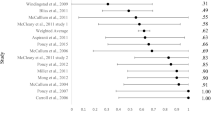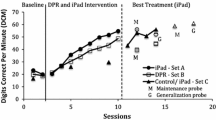Abstract
We used a multiple baseline design across math facts to evaluate classwide use of a taped problem (TP) intervention on first graders’ digits correct per minute in a general education classroom. During TP, students attempted to respond to each math fact before they heard the answer on an audiotape. As problems were repeated, response intervals were varied and individual and group feedback and rewards were provided contingent upon improved performance. Across all 3 sets of problems, digits correct per minute increased following the use of TP. We discuss the efficacy of TP as an instructional (as opposed to remedial) procedure, practical implications for teachers, and areas for future research.
Similar content being viewed by others
References
Billington, E. J., Skinner, C. H., & Cruchon, N. M. (2004). Improving sixth-grade students perceptions of high-effort assignments by assigning more work: Interaction of additive interspersal and assignment effort on assignment choice. Journal of School Psychology, 42, 477–490.
Bliss, S. L., Skinner, C. H., McCallum, E., Saecker, L. B., Rowland, E., & Brown, K. S. (2010). A comparison of taped problems with and without a brief post-treatment assessment on multiplication fluency. Journal of Behavioral Education, 19, 156–168.
Browder, D. M., Hines, C., McCarthy, L. J., & Fees, J. (1984). A treatment package for increasing sight word recognition for use in daily living skills. Education and Training of the Mentally Retarded, 19, 191–200.
Burns, M. K., Dean, V. J., & Klar, S. (2004). Using curriculum-based assessment in the responsiveness to intervention diagnostic model for learning disabilities. Assessment for Effective Intervention, 29, 47–56.
Carnine, D. (1976). Effects of two teacher presentation rates on off-task behavior, answering correctly and participation. Journal of Applied Behavior Analysis, 9, 199–206.
Carroll, E., Skinner, C. H., Turner, H., McCallum, E., & Woodland, S. (2006). Evaluating and comparing responsiveness to two interventions designed to enhance math fact fluency. School Psychology Forum: Research in Practice, 1, 28–45.
Cates, G. L., & Rhymer, K. N. (2003). Examining the relationship between math anxiety and math performance: An instructional hierarchy perspective. Journal of Behavioral Education, 12, 23–34.
Codding, R. S., Shiyko, M., Russo, M., Birch, S., Fanning, E., & Jaspen, D. (2007). Comparing mathematics interventions: Does initial level of fluency predict intervention effectiveness? Journal of School Psychology, 45, 603–617.
Deno, S., & Mirkin, P. (1977). Data-based program modification: A manual. Reston, VA: Council for Exceptional Children.
Fuchs, L. S. (2003). Assessing intervention responsiveness: Conceptual and technical issues. Learning Disabilities: Research and Practice, 18, 172–186.
Gagne, R. M. (1983). Some issues in the psychology of mathematics instruction. Journal for Research in Mathematics Education, 14, 7–18.
Haring, N. G., & Eaton, M. D. (1978). Systematic instructional procedures: An instructional hierarchy. In N. G. Haring, T. C. Lovitt, M. D. Eaton, & C. L. Hansen (Eds.), The fourth R: Research in the Classroom (pp. 23–40). Columbus, OH: Merrill.
Hasselbring, T. S., Goin, L. I., & Bransford, J. D. (1987). Developing fluency. Teaching Exceptional Children, 1, 30–33.
Herman, S. H., & Tramontana, J. (1971). Instructions and group versus individual reinforcement in modifying disruptive group behaviors. Journal of Applied Behavior Analysis, 4, 113–119.
Lloyd, J. W., Eberhardt, M. J., & Drake, G. P. (1996). Group versus individual reinforcement contingencies within the context of group study conditions. Journal of Applied Behavioral Analysis, 29, 189–200.
McCallum, E., Schmitt, A. J., Schneider, D. L., Rezzetano, K., & Skinner, C. H. (2010). Extending research on the taped-problems intervention: Do group rewards enhance math fact fluency development? School Psychology Forum: Research in Practice, 4, 44–61.
McCallum, E., Skinner, C. H., & Hutchins, H. (2004). The taped-problems intervention: Increasing division fact fluency using a low-tech self-managed time-delay intervention. Journal of Applied School Psychology, 20, 129–147.
McCallum, E., Skinner, C. H., Turner, H., & Saecker, L. (2006). The taped-problems intervention: Increasing multiplication fact fluency using a low-tech, class-wide, time-delay intervention. School Psychology Review, 35, 419–434.
McCleary, D. F., Aspiranti, K. B., Skinner, C. H., Luna, E., Murray, K., McCane-Bowling, S. J., & Woody, A. (2011). Enhancing math-fact fluency via taped-problems in intact second- and fourth-grade classroom. Journal of Evidence-Based Practices in the Schools, 12, 179–201.
McCurdy, B. L., Cundari, L., & Lentz, F. E. (1990). Enhancing instructional efficiency: An examination of time delay and the opportunity to observe instruction. Education and Treatment of Children, 13, 226–238.
McCurdy, M., Skinner, C. H., Grantham, K., Watson, T. S., & Hindman, P. M. (2001). Increasing on-task behavior in an elementary student during mathematics seat-work by interspersing additional brief problems. School Psychology Review, 30, 23–32.
National Association of State Directors of Special Education and Council of Administrators of Special Education. (2006). Response to intervention: NASDSE and CASE white paper on RTI. Instruction Research Brief.
National Center for Educational Statistics. (2009). The nation’s report card: Mathematics 2009. Washington, DC: U.S. Department of Education.
National Council of Teachers of Mathematics. (2007). Effective teaching for the development of skill and conceptual understanding of number: What is the most effective? Instruction Research Brief.
Poncy, B. C., Skinner, C. H., & Jaspers, K. E. (2007). Evaluating and comparing interventions designed to enhance math fact accuracy and fluency: Cover, copy, and compare versus taped problems. Journal of Behavioral Education, 16, 27–37.
Porter, A. (1989). A curriculum out of balance: The case of elementary school mathematics. Educational Researcher, 18, 9–15.
Shapiro, E. S., Albright, T. S., & Ager, C. L. (1986). Group versus individual contingencies in modifying two disruptive adolescents’ behavior. Professional School Psychology, 1, 105–116.
Skinner, C. H. (1998). Preventing academic skills deficits. In T. S. Watson & F. Gresham (Eds.), Handbook of child behavior therapy: Ecological considerations in assessment, treatment, and evaluation (pp. 61–83). New York, NY: Plenum Press.
Skinner, C. H. (2002). An empirical analysis of interspersal research: Evidence, implications and applications of the discrete task completion hypothesis. Journal of School Psychology, 40, 347–368.
Skinner, C. H., Belfiore, P. J., Mace, H. W., Williams, S., & Johns, G. A. (1997). Altering response topography to increase response efficiency and learning rates. School Psychology Quarterly, 12, 54–64.
Skinner, C. H., Fletcher, P., & Henington, C. (1996). Increasing learning trial rates by increasing student response rates. School Psychology Quarterly, 11, 313–325.
Skinner, C. H., & McCleary, D. F. (2010). Academic engagement: Strategies to increase active, accurate and academic responding. In A. Canter (Ed.), Helping children at home and school-III: Handouts from your school psychologist, (pp. S3–1–S3–4). Bethesda, MD: National Association of School Psychologists.
Skinner, C. H., & Schock, H. H. (1995). Best practices in math assessment. In A. Thomas & J. Grimes (Eds.), Best practices in school psychology (3rd ed.; pp. 731–740). Washington, DC: National Association of School Psychologists.
Skinner, C. H., & Shapiro, E. S. (1989). A comparison of a taped-words and drill interventions on reading fluency in adolescents with behavior disorders. Education and Treatment of Children, 12, 123–133.
Skinner C., & Smith, E. (2002). Issues surrounding the use of self-managed interventions for increasing academic performance. School Psychology Review, 21, 202–210.
Windingstad, S., Skinner, C. H., Rowland, E., Cardin, E., & Fearington, J. (2009). Extending research on a math fluency building intervention: Applying taped-problems in a second-grade classroom. Journal of Applied School Psychology, 25, 364–381.
Author information
Authors and Affiliations
Corresponding author
Additional information
This work was completed with the support of the Korn Learning, Assessment, and Social Skills Center at The University of Tennessee.
Rights and permissions
About this article
Cite this article
Aspiranti, K.B., Skinner, C.H., McCleary, D.F. et al. Using Taped-Problems and Rewards to Increase Addition-Fact Fluency in a First Grade General Education Classroom. Behav Analysis Practice 4, 25–33 (2011). https://doi.org/10.1007/BF03391781
Published:
Issue Date:
DOI: https://doi.org/10.1007/BF03391781




